Sira Tanager. Does it really exist?
Sira Mountains, Peru – revisited!
I have just come back from my third trip to the wilderness area of Cerros de Sira not far from Pucallpa. Sira has a familiar ring to the Neotropical birder. Yes, of course it is that Tanager with only a dot on the distribution map in any guide book over South American birds that include all birds of Peru or all Tanagers. It was also my third dip! I am wondering seriously if the bird really exists.
In spite of not seeing a single life bird, I am still promoting trips to Sira mountains. Last time was 3 years ago. It will not take three years before I go back again. That is for certain. Why? I tell you why! Here are the main reasons why I will go – and maybe you want to come with me.
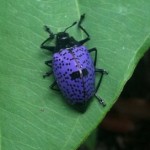 Wilderness and untouched. This is far from the Coca Cola trail. It is hiking a montane rain forest. Sure, it is a bit buggy, but there is a freedom experience to go head straight into the jungle on a quest to see Sira Tanager! And some bugs are actually quite cool, when you think of it. I have no idea what this is!
Wilderness and untouched. This is far from the Coca Cola trail. It is hiking a montane rain forest. Sure, it is a bit buggy, but there is a freedom experience to go head straight into the jungle on a quest to see Sira Tanager! And some bugs are actually quite cool, when you think of it. I have no idea what this is!- With lots of luck there is a chance to see rarely seen birds such as the Sira from of Horned Curassow (quite certainly a good species) and possibly the undescribed form of Scarlet-banded Barbet which was recently found in the Southern part of the Sira Mountains (no reason why it should not be here as well).
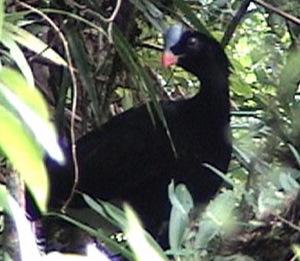 In fact, I heard the Curassow as it grunted around the corner of the trail (and of course disappeared!) and I made a recording of what sounds very similar to the recording of the new barbet on McCauley library. Compare this with my mystery recording of a Barbet or Antpitta that I just uploaded to Xeno-canto. Did not see the bird though. We shall see what the discussion on Xeno-canto may lead to. Of course my main reason apart from trying to see the Tanager is to try to see these two birds. Looks like I was very close this time. Being close is also a thrill, and makes it even more desirable to go back.
In fact, I heard the Curassow as it grunted around the corner of the trail (and of course disappeared!) and I made a recording of what sounds very similar to the recording of the new barbet on McCauley library. Compare this with my mystery recording of a Barbet or Antpitta that I just uploaded to Xeno-canto. Did not see the bird though. We shall see what the discussion on Xeno-canto may lead to. Of course my main reason apart from trying to see the Tanager is to try to see these two birds. Looks like I was very close this time. Being close is also a thrill, and makes it even more desirable to go back. 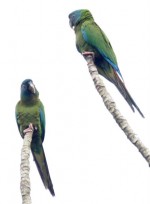 We saw many good birds that are rare or difficult elsewhere such as Cerulean-capped Manakin (common), Gray-tailed Piha, Sharpbill, Scarlet-throated and Fiery-throated Fruiteaters, Rufous-webbed Brilliant (very common), Yellow-throated Tanager (very common), Blue-browed Tanager and we heard Rufous-brown Solitaire. No Wing-barred Wren on this trip, but I have seen it before here.
We saw many good birds that are rare or difficult elsewhere such as Cerulean-capped Manakin (common), Gray-tailed Piha, Sharpbill, Scarlet-throated and Fiery-throated Fruiteaters, Rufous-webbed Brilliant (very common), Yellow-throated Tanager (very common), Blue-browed Tanager and we heard Rufous-brown Solitaire. No Wing-barred Wren on this trip, but I have seen it before here.- Very good for Owls. Subtropical Pygmy-Owl, Vermiculated Screech-Owl, Band-bellied Owl and a Ciccaba which I presume is Black-banded Owl (only
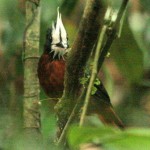 one note grunt).
one note grunt). - Many good birds also in the lowlands along the 9km stretch of road to the start of the trail such as Slender-billed Kite, Blue-headed Macaw, White-plumed Antbird and Curl-crested Aracari.
- Wonderful butterflies.


Yes, there were birds!
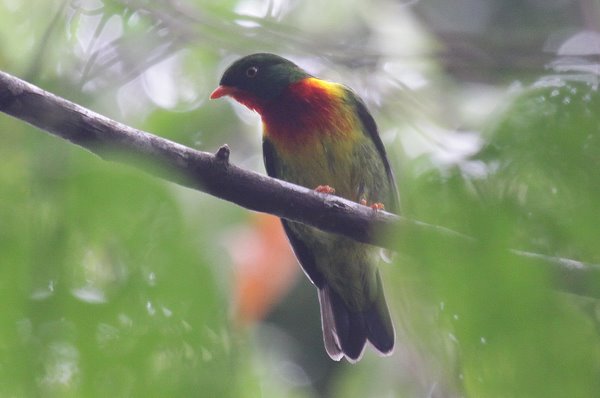
Scarlet-breasted Fruiteater Pipreola frontalis ssp. frontalis. Photo: Gunnar Engblom. Seen several times at around 1200-1400m.
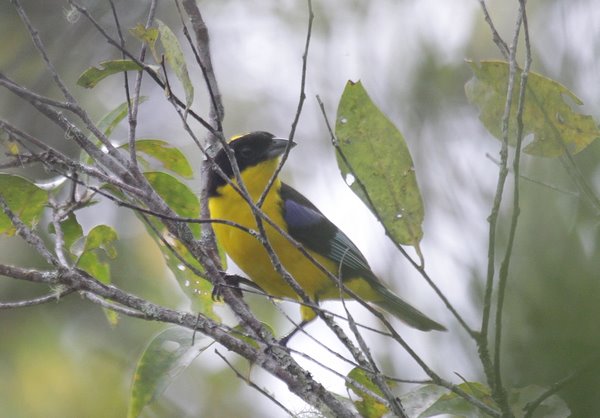
Blue-winged Mountain-Tanager Anisognathus somptuosus. Photo: Gunnar Engblom. Common in the dwarf forest around 1400m
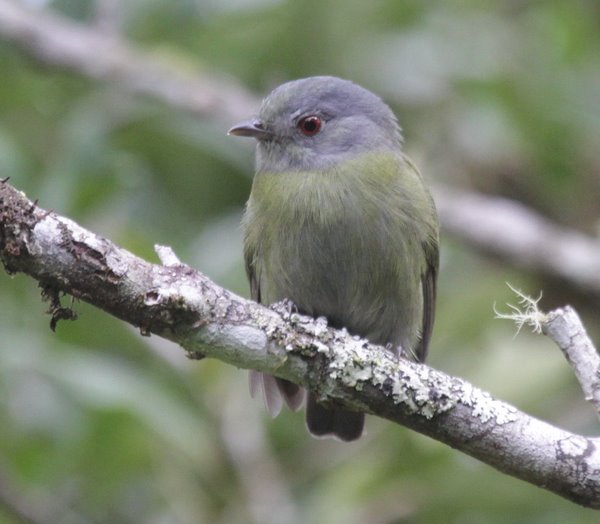
White-crowned Manakin. Dixiphia pipra female. Andean form. Photo: Gunnar Engblom. We also saw the male of this cute bird.
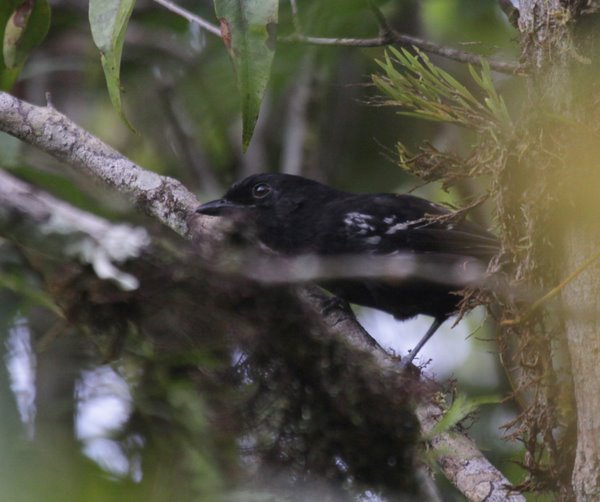
A Variable Antshrike Thamnophilus caerulescens was sneaking around in the bushes at 1500m . Photo. Gunnar Engblom
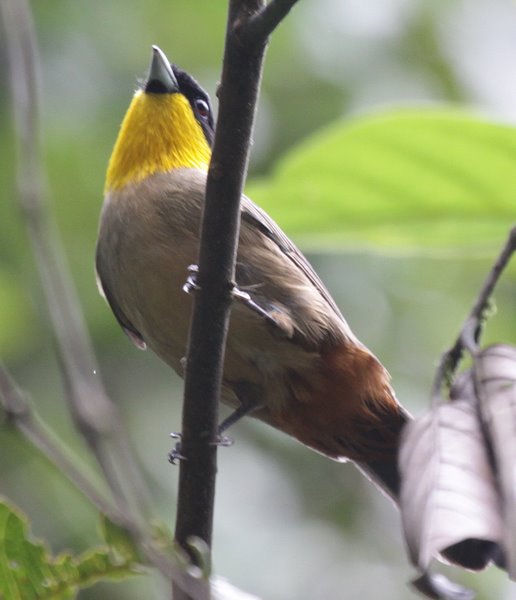
The beautiful Yellow-throated Tanager Iridosornis analis was dead common between 1200-1535m. Photo: Gunnar Engblom
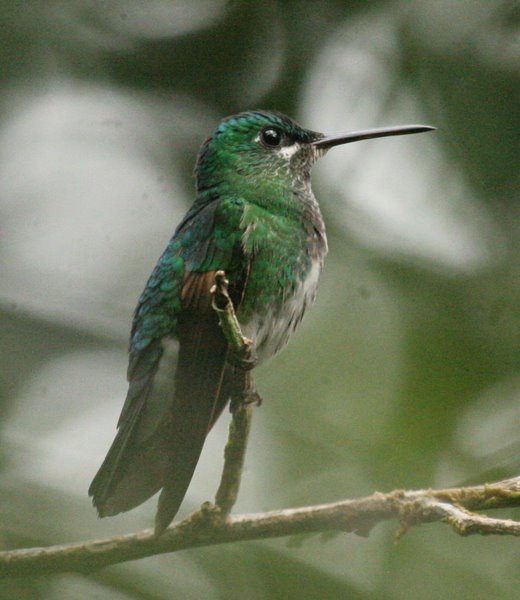
Rufous-webbed Briliiant Helidoxa-branickii was very common above 1200m. This is a very difficult bird to see elsewhere such as on the Manu road. Here a female. Photo: Gunnar Engblom
Plans for eco-tourism
In reality is a bit strange why not more people come and visit Reserva Comunal de Sira. The access is very good with a large airport at Pucallpa with regular jet-flights.
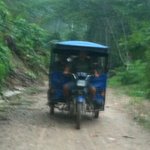 One may also reach Pucallpa easily overland as there are buses direct from Lima (and good birding on the way in Carpish and Tingo Maria). From Pucallpa it is a good dirt road to Puerto Inca which only takes 3 hours. Puerto Inca has a decent hotel, telephone, internet and cold beer. One even can cut the long walk, as there is now a good road for 9km towards the base of the hills served with Moto-taxis – the favorite transport in jungle towns.
One may also reach Pucallpa easily overland as there are buses direct from Lima (and good birding on the way in Carpish and Tingo Maria). From Pucallpa it is a good dirt road to Puerto Inca which only takes 3 hours. Puerto Inca has a decent hotel, telephone, internet and cold beer. One even can cut the long walk, as there is now a good road for 9km towards the base of the hills served with Moto-taxis – the favorite transport in jungle towns.
The Community Reserve is shared between several indigenous communities. An interesting report about the problems the reserve is facing can be found on ParksWatch Sira report. In any case, tourism should be developed so it benefit the local people. Birding could serve as a initial activity, but in the long run it is is needed to promote it to a wider public. I am of the idea, that if it becomes somewhat easier to visit for birders, this may well catalyze the regular tourism. The park authorities SERNANP are interested in these ideas and have some funding to execute a pilot project. Hopefully, we can make a pilot trip with SERNANP in April-May and I shall put some departures in our Kolibri Expeditions itineraries for July-October. I will also assist anyone who want to go to Sira independently. What needs to be done to facilite for birders is improving the trails – making them wider and easier to follow and install some ready camps with platforms and thatched roofs in order to make camping less uncomfortable and allow for larger groups. For now it is difficult to put more than a few tents at each place.
All in all, Sira has lots to offer and Puerto Inca is in my opinion the best place to access these remote mountains.

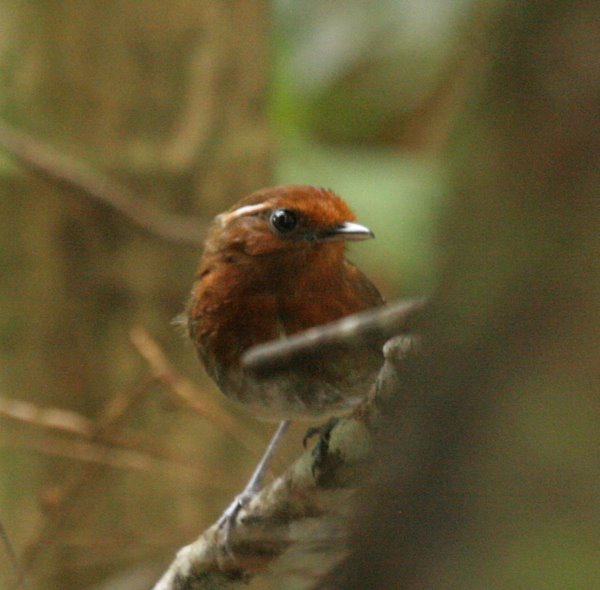

I’d love to go there some day! The cool blue bug looks like a member of Erotylidae, the pleasing fungus beetle family.
Rich, thanks for the ID of the bug! Pleasing indeed!
Gunnar Engblom-Lima, Peru.
Gunnar’s Blog – updated frequently.
https://www.kolibriexpeditions.com/birdingperu/blog/
Follow me on https://www.twitter.com/kolibrix
https://www.facebook.com/Gunnar.Engblom/
Wow Gunnar, Looks like a great place to bird. With some beautiful bugs and butterflies. I would love to go there as well…..maybe …Someday!
My invitation to one of our project tours (Satipo&Carpish – or Tambopata
overland) stands for 2011, Dawn….make a combination!! You could do a
combination!! If you are in for the hiking!
Gunnar
Gunnar Engblom-Lima, Peru.
Gunnar’s Blog – updated frequently.
https://www.kolibriexpeditions.com/birdingperu/blog/
Follow me on https://www.twitter.com/kolibrix
https://www.facebook.com/Gunnar.Engblom/
Hi Gunnar,
Sorry to hear about the dip on the Sira Tanager. Was it as dry this time as the last time we were there? I often think of that trip…in fact I get reminded of it everytime I get out of bed.
Hope you and family are doing well.
Skip, no we had considerable rain… and yet no Tanager. My only guess is
that we were still too low. In hindsight….in 2007 we were not even close.
Otherwise the family and myself are great. How is your knee..?
Gunnar Engblom-Lima, Peru.
Gunnar’s Blog – updated frequently.
https://www.kolibriexpeditions.com/birdingperu/blog/
Follow me on https://www.twitter.com/kolibrix
https://www.facebook.com/Gunnar.Engblom/
Thanks for the great report, adding another site to my extensive wish list.
Brian
Def one you should do Brian. Especially with your email as it is …..!
Gunnar Engblom-Lima, Peru.
Gunnar’s Blog – updated frequently.
https://www.kolibriexpeditions.com/birdingperu/blog/
Follow me on https://www.twitter.com/kolibrix
https://www.facebook.com/Gunnar.Engblom/
😉 I guess it does:
https://www.flickr.com/photos/42595788@N00/3725117536/
https://www.flickr.com/photos/42595788@N00/3724307183/
amazing bird!!
Diego, I actually got permission from Michael Harvey to use his photo. SO now it is right there on top. Thanks for pointing it out.
I know this has been posted for over a year and I know the tanager would be a great add to my lifelist, but I have to say that as a Bird-Photographer, that White-plumed Antbird make’s me dream!
Alex, I really think the foot of the Sira is a great place for White-plumed Antbird. It was dominating in the Antswarm I came across.